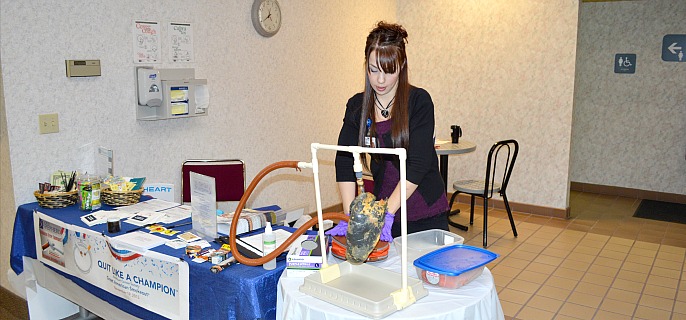
Statistics on cigarette smoking show both good news and bad news. The good news? The percentage of Americans who smoke has fallen by more than half in the last 50 years. The bad news? The percentage of people who smoke in Umatilla County is higher than the state average.
Back in 1964, when the surgeon general first issued warnings about the dangers of cigarette smoking, a total of 42 percent of Americans smoked. Today, that percentage is down to 18 percent. Statewide, 19 percent of Oregonians smoke, but in Umatilla County, that figure jumps to 23 percent.
On Thursday, Good Shepherd Medical Center spent the day encouraging smokers to quit – at least for a day – during the annual Great American Smokeout. Educational displays were set up at various locations at the hospital with information and resources to help people kick the deadly habit.
Nichole Cribbs works in the hospital’s education department. She said smokers often face multiple hurdles in their effort to stop smoking. The first is the addictive qualities of nicotine. Today’s cigarettes contain chemicals that make them even more addictive, causing the brain to crave the burst of dopamine that comes with the inhalation of nicotine.
Secondly, there is often a social aspect that makes giving up tobacco an even more difficult challenge.
“I had a gal tell me today that she started smoking because her boyfriend smoked and it was one of the only times during the day they could spend together talking about their day,” Cribbs said. “She was reluctant to quit because she thought she’d lose that time with her boyfriend.”
To help encourage smokers to quit, Cribbs and others at the hospital passed out literature along with nicotine patches to those who turned in their cigarettes, chewing tobacco and vapor pens.
Cribbs also had on display two lungs – one was a healthy pig lung that was pink and could fully expand with oxygen. The other was an actual lung from a longtime smoker. The smoker’s lung was discolored, could not fully inflate and leaked oxygen. It was a startling visual.
But studies show, however, that damage to lungs from cigarette smoke can be reversed, said Cribbs. It can take up to 15 years for a former smoker’s lungs to regain full capacity, but it can happen, she said.
“A lot of people feel the damage is done and there’s nothing you can do to reverse it,” she said. “But say you’re 65 – there’s still time for you to get your lungs healthy again. It’s never too late.”
And, there are more immediate benefits to quitting. After 20 minutes from your last cigarette, your heart rate and blood pressure drop. After 12 hours, the carbon monoxide level in your blood drops to normal. Within two to three weeks, your circulation improves, and your lung function increases. And after one year, the excess risk of coronary heart disease is half that of a continuing smoker’s.
And while the Great American Smokeout was a one-day event, Good Shepherd offers smoking cessation classes throughout the year. For more information, call 541-667-3509.









